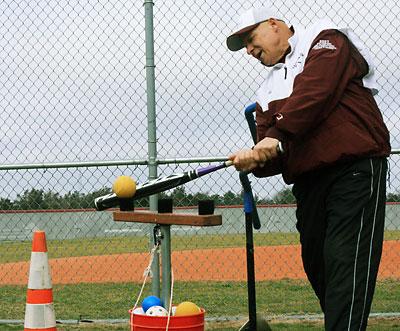Tyros Improving at a Rapid Rate, Softball Coach Says

When spring practice first began at the beginning of this month, Lou Reale’s response on being asked how East Hampton High School’s softball team looked was to roll his eyes.
He’s not rolling them anymore.
Asked during a well-attended hitting and fielding clinic for third-through-eighth graders and their coaches Sunday morning how the varsity’s recent scrimmages with Hampton Bays and Center Moriches went, the coach said, brightening, “We did great! We’ve got a lot of young kids, but they’ve improved more over the first two weeks than any other group I’ve ever had. I don’t want to jinx them, but they’ve been unbelievable. We practiced for 3 hours and 40 minutes yesterday and nobody complained.”
Casey Waleko, an all-state pitcher as an eighth grader, who has recovered from the wrist problem that bothered her last season, and Sam Mathews shared the mound in the scrimmages, and each, said Reale, threw well. The team hit well too, he said.
If they’ve paid any attention to his instruction, that’s no surprise, for Reale, as he demonstrated Sunday in what could justly be called an hourlong master class for coaches on the subject, went through a number of drills, using various hitting aids, some oddly formed — and some, like a notched bleacher seat to test balance, of his own invention — designed to produce the perfect softball swing.
Number one, he told the coaches, the hitting T should be placed about a foot in front of home plate, in “the hitting zone,” not on the plate, as is commonly done. “Home plate is not in the hitting zone,” Reale said.
The “door-knocking knuckles should be aligned” when holding the bat, and its knob should face the ball. The feet should be shoulder-width apart, the lower elbow in the slot, and the legs slightly bowed (“I would have had no problem with that before my knee-replacement operation!”). The back shoulder should not be raised, but ought to point down.
In coming through, the hips rotate down to give power, and the hands should be up, with one on top of the other, and should stay inside the ball and above it. Your weight’s going forward. Bat speed is generated from the hips down. . . . The lighter the bat the better for building muscles and bat speed. The follow-through is high.
“The baseball swing is different,” Reale said during a brief conversation afterward. “There’s a slight uppercut, but in softball you want your swing to be level with the ball and you want to keep it in the hitting zone as long as possible. If you swing with an uppercut in softball, you won’t be able to hit the riser, you’ll be in and out of the zone too quick.”
After his detailed talk on hitting, Reale joined his assistant, Erin Abran, and the varsity players, in overseeing the younger clinic-takers’ fielding drills. Outfielders, he said, ought to put two fingers in the pinky hole in order to more easily close their gloves, while infielders should have a finger in each hole to spread their hands out more.
Outfielders were told to keep their heads steady and to run quietly when chasing fly balls, and to bend down on a knee and spread themselves out, thus creating a larger target, when fielding grounders. When charging a ball, they were told to field it on the inside of their glove-side foot and to follow through toward their target, holding the ball across the seams.
Snap turns of the neck, which were to be executed smartly, alternately looking left and right as they tracked a ball blown by the wind while running backward, proved to be a problem for most. But there are more Sunday morning clinics to come, the next on April 1, and then, following the varsity’s spring training trip to Disney World, on April 22.
Getting back to the team, Reale said Ilsa Brzezinski, a sophomore who was the junior varsity’s catcher last year, is on first; Ceire Kenny, a sophomore who pinch-ran last season, is on second; Ali Harned, a freshman who pitched for the Montauk School last spring, is the shortstop; Deryn Hahn, a senior, is back at third, and Kathryn Hess, a senior all-state catcher, is behind the plate.
Dana Dragone, a senior, is in left field, backed up by Shannen McCaffrey, a sophomore up from the jayvee; Eli Cassel, a sophomore, also up from the jayvee, is in right, and Courtney Dess, a senior, with McCaffrey and Lia Makrianes, a freshman, as backups, is in center. Cecelia Fioriello, a sophomore who caught for the jayvee last spring, is Hess’s backup.
And Waleko and Mathews, as aforesaid, are the pitchers, though Waleko is expected to do most of it. “We’ll get Sam into the lineup though — she’s too good a hitter,” said Reale. “Either DH-ing or at first base. In fact, because we don’t have that many players, we’re going to try to give everybody a chance at playing different positions.”
